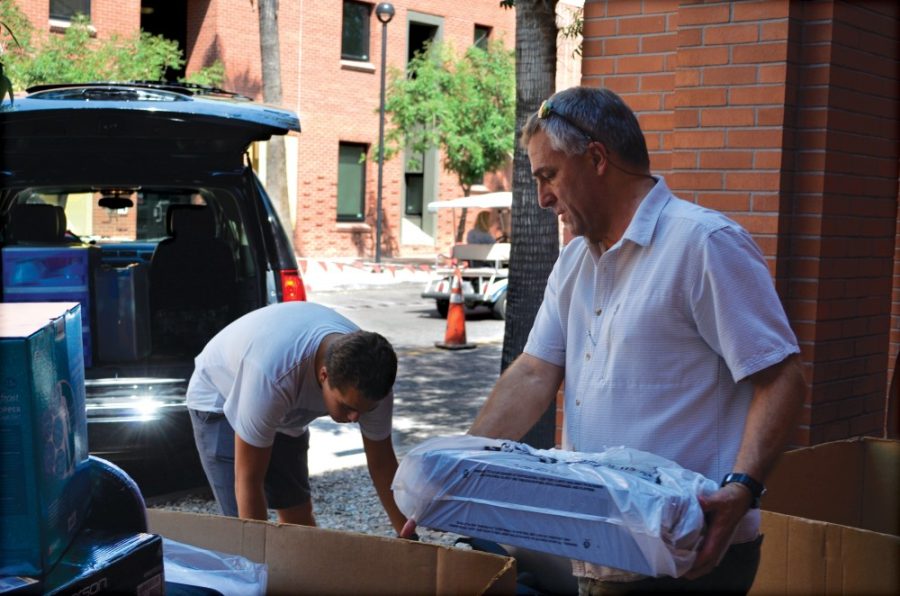As incoming class sizes at the UA continue to tick upward, the space available in residence halls is becoming much more limited, and students are finding themselves in temporary housing situations.
The UA said it has no plans to limit future enrollment or create new housing at this time, even though more students are living in on-campus housing than the total capacity for residence halls allows.
The UA welcomed more than 8,100 freshmen this year, which is an increase of about 150 from last year.
“This is the largest freshman class we have ever had,” said Kasey Urquidez—the UA’s vice president for enrollment management and dean of undergraduate admissions—in a UANews press release. “This is an exciting time for our University as we grow and increase opportunities.”
The current population of students living in residence halls on campus is about 7,000, according to Jennifer Hiatt, the executive director of Residence Life.
The capacity for the 24 residence halls on campus is about 6,900, according to Residence Life.
A resident assistant—who requested anonymity because he is not authorized to speak to the media—at Pueblo de la Cienega Residence Hall said that his hall was overbooked. As a result, he said students in his wing are living in study rooms converted into dorm rooms until a permanent living space becomes available.
The RA said the wing can house 39 students and that capacity has been met. An additional five students live in two converted study rooms. Those students were given notice that they could be living in the study rooms for two weeks to the entire semester.
“Overcrowding exists in pretty much all the dorms where there are livable study areas for students to be placed in,” the RA said.
Hiatt said progress is being made in getting students into permanent rooms.
“This week, Residence Life has been able [to] start moving some students from the temporary living spaces to dorm rooms as spaces become available,” Hiatt said.
Hiatt said that Residence Life wants to give all students the opportunity to live on campus and will not limit the number of students who are able to apply to on-campus housing. She added that there are no current plans from the UA to add more residence halls.
“Residence Life and the university are currently considering options, but as for right now, there are no plans [to] expand on-campus housing for the next school year,” Hiatt said.
The newest residence hall, added last year, is Rawls/Eller Lodge—the former home of the now-shuttered Phi Gamma Delta fraternity. Rawls/Eller Lodge, however, is the smallest residence hall on campus with a capacity for 64 students.
Urquidez said in an email that increasing enrollment is in step with the Arizona Board of Regents’ 2020 goals for state universities.
“The Never Settle plan calls for an additional 125 new freshmen per year through 2020. As we near 2020, we will reassess,” said Urquidez when asked about possibly limiting the number of freshman enrollment due to the university’s limited availability for on campus housing.
Never Settle is the strategic plan implemented by UA President Ann Weaver Hart to reach the board’s 2020 goals.
First-year students constitute about 80 percent of residence hall population, according to Residence Life’s website.
Unlike some other universities, the UA does not require freshmen or new transfer students to live on campus, so living off campus is always an option for freshmen.
Off-campus student apartment complexes have been rising across Tucson in the past few years, and the UA finds itself relying more on them to house students.
Hub at Tucson and Next are the two newest student apartment complexes that opened near the UA in the fall of 2014, located near the intersection of Speedway Boulevard and Park Avenue.
Those new complexes also come one year after Level and The Cadence—which is the only UA-affiliated, off-campus property—opened their doors to house UA students.
After being open for a year, the 14-story Hub at Tucson is beginning construction of a second complex, called Hub at Tucson II.
According to building plans, the new complex will be shorter, standing at six stories tall, and have a total of 104 residential units. The new complex is expected to be complete for the fall 2016 school year.
The Pueblo de la Cienega RA said he doesn’t think the number of students living in temporary housing should be viewed as a problem for the UA.
“It shows that the university is in high demand and that a large number of freshman students want to live in the residence halls, so the residence halls have a good reputation to students who are coming onto campus,” he said.
Follow Danielle Zalewski on Twitter.








